Fri 11 Jul 2008
Archived Review: MANNING LEE STOKES – The Dying Room.
Posted by Steve under Authors , Characters , Crime Fiction IV , Reviews[21] Comments
MANNING LEE STOKES – The Dying Room. Mercury Mystery #124; digest-sized paperback; no date stated. Hardcover edition: Phoenix Press, 1947.
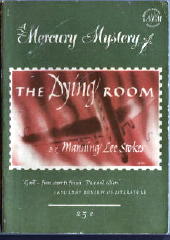
This is strange — really strange, as a matter of fact. There are six copies of this book available for sale on ABE as I type this, and five of them are the paperback version. Guess which one’s the least expensive? The hardcover edition from Phoenix. Even without a dust jacket on the hardcover, explain that if you can.
Manning Lee Stokes was born in 1911 and died in 1976, and at best, he had what you might call a mixed writing career. The Dying Room was one of his earliest books — his first four were published by Phoenix, beginning in 1945, and in chronological order, this one’s the third. From Phoenix he went to paperback originals (Graphic Books) and then wrote several others for another designed-for-libraries hardcover publisher, Arcadia House. One book was published Dell in 1958, but from 1960 on, he wrote nothing that appeared under his own name.

He wrote some of the early Nick Carter spy thrillers from Award in the 1960s, for example, a few of the John Eagle “Expeditor” men’s adventure novels from Pyramid in the 1970s as by Paul Edwards, and as Ken Stanton, all eleven of the “Aquanauts” books (with leading character Tiger Shark) that came out from Macfadden and Manor, also in the 1970s. (I have all the Expeditor books, I believe, but I have no explanation as to why I have NONE of the Aquanauts books.)
Stokes also wrote some of the sex-oriented SF-Fantasy “Blade” novels from Pinnacle, or so I’m told, but there’s certainly no reason to go into that, or at least not here. One other series character whom he created and who is worth mentioning is Christopher Fenn, who solved a couple of the cases from Arcadia House in the late 1950s, including The Case of the Presidents’ Heads, shown smoewhere below and to the left. Fenn was a private eye or criminologist of perhaps no great renown, but he is listed on Kevin Burton Smith’s PI website, so he has not been totally forgotten.
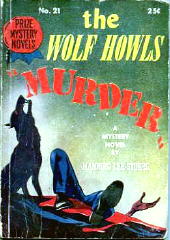
But there is private eye that Kevin does not know about — a rare event — a gent called Barnabas Jones who appeared in both The Wolf Howls “Murder” (Phoenix Press, 1945) and Green for a Grave (Phoenix Press, 1946). And something that Al Hubin does not know about (yet) is that Barnabas Jones also shows up for a short appearance in The Dying Room. Even though Jones is not the leading character and his part is small, his role is a relatively important one, substantially more than a walk-on or cameo, and I’ll get there very shortly.
Before I do, however, let me say this up front. The Dying Room is a much better book — and detective novel — than I expected it to be. Phoenix Press is not noted for its gems and works of art in the world of crime and mystery fiction, but you could do much worse than finding a copy of The Dying Room to read somewhere and somehow, hopefully not paying too much for it, no more than ten to fifteen dollars or so, and maybe less if you’re lucky. (My copy cost me five dollars if you were to split the money up as part of a group lot, and when I found it among the others, my first reaction was that I paid too much.)
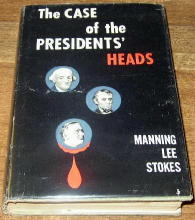
Telling the tale is Tom Fain, an ex-soldier with a splinter of a German shell embedded in his brain. About to be moved into the “dying room” at the Fort Tyner station hospital after his latest unsuccessful surgery, Fain decides to make a break for it. And with the help of a sympathetic nurse’s aide named Helen, escape he does.
On his way to see his ailing stepmother, the only mother he has ever known, he stops to visit with an old friend — the aforementioned Barnabas Jones, who offers him a job, but with other things on his mind at the time, Fain turns him down. (Mr. Jones makes another appearance and more importantly, in his professional capacity, later on.) Failing to reach his stepmother before she died, and avoiding a pickup by a pair of MP’s on his trail, Fain heads back to New York (and Helen) on an airplane — which is where the story begins, or at least the mystery part.
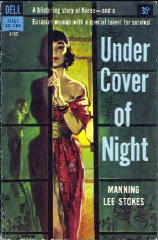
Fain sits next to a good-looking girl — no, change that, make it a beautiful girl — with whom he strikes up a lively conversation. Things are going well, but there’s nothing like a small disaster to get a story really going. Both Fain and the girl survive the crash. He’s more or less OK, but she is not. Her memory is gone, and a new one — one of her former life — has replaced it. Unfortunately there is a two-year gap in what she remembers. She doesn’t remember Fain, but being convinced that he helped save her life, she invites him to her new (old?) home to recover.
There was a question mark there, as you will have noticed. Is the girl the missing heir to a considerable fortune? Or is she a fraud? Fifty million dollars is at stake. (I did say considerable.) Several persons try to hire him — it turns out that he, before the war, was a private eye himself. And as it turns out, and not too surprisingly, someone is playing a dangerous (and deadly) game, and Fain, as he quickly discovers, was never given the rules under which it’s being played.
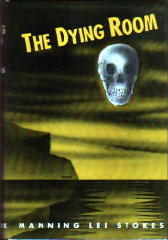
But as a detective, Fain gives his clients their money’s worth, and in similar fashion does Stokes the author. A six-point summary on page 98 is as precise and to the point as any I’ve read in a work of detective fiction in quite a while. No power point presentation could have produced anything better.
The ending gets a little too melodramatic, perhaps — well, no perhaps about it — and the prologue most certainly could have been ditched, which very nearly goes without saying, as most prologues could be (should be) ditched, but (and this is a big but) this book is as entertaining as anything I’ve watched on television this week.
That someone never recognized that this book would make for an awfully good movie is something to be regretted. Filmed in black-and-white, with some professionally done noir-ish touches, perhaps, maybe even a great one.
[UPDATE] 07-11-08. Looks like I never told Kevin about Barnabas Jones, but I will today. (One of course wonders immediately if the gent is related to the later Barnaby Jones of TV fame. Probably not. There are a lot of Joneses in this country.)
Barnabas Jones’s brief appearance in The Dying Room is now included in Part 5 of the online Addenda to the Revised Crime Fiction IV, along with a complete listing for each of the PI series he did, both early in his career.
July 14th, 2008 at 9:05 am
I didn’t notice you mention the graphic novel Stokes wrote in the late 1940’s (or the early 50’s). Some consider it to be the first graphic novel. It’s been reprinted rather recently and should be easy to find. As usual, I don’t have time to dig up my references. The Case of the Laughing Buddha or some such. It’s not a novel, even though (at least the early editions of) Hubin’s bibliography treats it as such. Maybe more later.
July 14th, 2008 at 10:20 am
Juri
According to Wikipedia:
It Rhymes with Lust has been mentioned previously here on the blog, in a write-up about Arnold Drake when he died.
Lust has recently been reprinted; I haven’t found anything to indicate that Buddha has, but I could easily be wrong about that.
I have a copy of Lust, and it’s a novel all right, only told in comic book form (but digest-sized).
Both books are in the Revised Crime Fiction IV. If you can say anything more as to why Buddha shouldn’t be, let me know and out it goes!
July 15th, 2008 at 2:17 am
Yes, sorry, of course it’s It Rhymes With Lust, not The Case of the Winking Buddha, that I was thinking! And the latter certainly has never been reprinted, sorry ’bout that, too.
Should they be in Revised Crime Fiction IV? Don’t really know. They are graphic novels (i.e. comics, as some people still say), not prose novels, and I don’t know if, say, Azzarello’s 100 Bullets is in there, or the Sin City graphic novels of Frank Miller. Are they? If It Rhymes With Lust and The Buddha are there, so Azzarello’s and Miller’s works should be, too.
I forgot to say that I’ve read one of the Nick Carters Stokes wrote and it was hilarious, it seemed at times a parody. (And a funny one, not like those bore fests of John Gardner…)
July 15th, 2008 at 6:22 am
This is fascinating!
On including comics in Crime Fiction IV:
There are tens of thousands of comic books and graphic novels with crime and mystery content. Mr. Hubin would have to start a whole second bibliography just to include them all. It might just make more sense to regard them as out of scope.
July 15th, 2008 at 8:49 am
Juri and Mike
Don’t underestimate Al Hubin’s boundaries for what he includes in the Revised Crime Fiction IV. He may have missed a few crime-oriented graphic novels, maybe even quite a few, but if he has, I’m sure he’ll want to know about them.
Comic books, per se, are not included. That’s no different from collections of short stories, not in CFIV, or novels serialized in magazines, also not in CFIV.
But as I say, stories published in comic book form in a stand-alone format (i.e., graphic novels) are definitely included.
Keep in mind that what’s in CFIV has to have been published in th year 2000 or earlier, just before the present boom in graphic novels occurred.
This means that the first two volumes of Azzarello’s series of 100 BULLETS collections should be in, but they’re not. I’ll let Al know right away.
As for Frank Miller, here’s his current entry. If either of you know of any of his work that should be in (2000 and before) but it’s not, let me know. (It also looks as though Daredevil and Electra should be ID’ed as series characters. More for Al…!)
Best
Steve
MILLER, FRANK (1957- )
* * *Batman: The Dark Knight Returns (Warner, 1986, pb) [Batman] Titan, 1989. Graphic novel.
* * *Batman: Year One (Warner, 1988, pb) [Batman] Graphic novel.
* * *A Dame to Kill For (Milwaukee, WI: Dark Horse, 1994, pb) Titan, 1994. Graphic novel.
* * *Daredevil and the Punisher: Child’s Play (Marvel, 1988, pb) Graphic novel.
* * *Daredevil: Born Again (Marvel, 1987, pb) Graphic novel.
* * *Daredevil: Gang War (Marvel, 1992, pb) Graphic novel.
* * *Daredevil: Love and War (Marvel, 1986, pb) Graphic novel.
* * *Daredevil: Marked for Death (Marvel, 1990, pb) Graphic novel.
* * *Daredevil: The Man Without Fear (Marvel, 1994, pb) Boxtree pb, 1995. Graphic novel.
* * *Electra: Assassin (Graffiti Designs, 1989, pb) Graphic novel.
* * *The Elektra Saga (Marvel, 1989, pb) Graphic novel.
* * *Elektra: The Complete Saga (Marvel, 1984, pb) Graphic novel.
* * *Give Me Liberty (Milwaukee, WI: Dark Horse, 1990, pb) Penguin, 1991. Graphic novel.
* * *Hard Boiled (Milwaukee, WI: Dark Horse, 1990, pb) Graphic novel.
* * *RoboCop vs. Terminator (Milwaukee, WI: Dark Horse, 1992, pb) Titan, 1993. Graphic novel.
* * *Sin City: Family Values (Milwaukee, WI: Dark Horse, 1997, pb) Titan, 1997. Graphic novel.
* * *That Yellow Bastard (Milwaukee, WI: Dark Horse, 1997, pb) Graphic novel.
July 15th, 2008 at 1:28 pm
Steve,
As is evident, I guess, I do/did intend to include graphic novels in CFIV, but my efforts to make the coverage complete were sporadic and unsystematic, I’m afraid. Always glad to add any missed titles as long as I’m keeping up the addenda process.
Looks like the Azzarello entry should be like this:
AZZARELLO, BRIAN (J.). 1962- . SC: Agent Graves, in both titles, both graphic novels.
100 Bullets: First Shot, Last Call. DC/Vertigo pb, 2000
100 Bullets: Split Second Chance. DC/Vertigo pb, 2000
Right? If so, into #29.
Best,
Al
July 15th, 2008 at 1:36 pm
Steve,
…Looks like I need to add these to the Sin City series:
The Big Fat Kill. Dark Horse, 1996
Booze, Broads & Bullets. Dark Horse, 1998
The Hard Goodbye. Dark Horse, 1993
And identify these as in the Sin City series:
A Dame to Kill For
That Yellow Bastard
A cop named Hartigan is in some/several stories, but not apparently in all. Booze etc. is a collection of stories, for which I have the individual titles.
You’re right about Daredevil and Elektra being series characters…more evidence of my carelessness with graphic novels.
More for #29…
Best,
Al
July 16th, 2008 at 2:48 am
Steve, Al, Mike,
Nice to hear those (and other graphic novels) have been included. I can’t add anything to those titles (although I’ve written an entry for Frank Miller for a comics reference work in Finnish..).
Something to check upon: have any of the Nestor Burma graphic novels been translated in English? Jacques Tardi made a few from Leo Malet’s novels, and “120, Rue de le Gare” is a masterpiece, in my mind (and better than the original novel).
And what about the Spirit series of Will Eisner? Would think some of the would’ve been published as stand-alones. (I’m not really an expert in comics or graphic novels, just reading them with keen interest.)
July 16th, 2008 at 8:49 am
Juri
You’re right, and thanks. The Spirit books and collections should be in and they’re not.
The question on the others is whether they’ve been published in English or not. Either I or Al will check into it later today.
Best
Steve
July 16th, 2008 at 11:46 am
Based on the Wikipedia entry for The Spirit:
“The Spirit is a fictional American masked crime-fighter, created by writer-artist Will Eisner in 1940, who starred in a Sunday-newspaper comic-book insert. His namesake, seven-page weekly series is considered one of the comic-art medium’s most significant works, with Eisner creating or popularizing many of the styles, techniques, and storytelling conventions used by comics professionals decades later.
“The Spirit chronicled the adventures of a masked vigilante who fought crime with the blessing of the city’s police commissioner, an old friend. Despite the Spirit’s origin as a detective named Denny Colt, his real identity was virtually unmentioned again and for all intents and purposes he was simply ‘The Spirit.’ The stories ranged through a wide variety of styles, from straightforward crime drama and noir to lighthearted adventure, from mystery and horror to comedy and love stories, often with hybrid elements that twisted genre and expectations.”
… Al agrees that both Will Eisner and The Spirit should go in.
As for Burma and Tardi, neither seems to have been published in English.
Corrections or other suggestions welcome!
— Steve
July 27th, 2008 at 2:41 pm
“the Case of the Winking Buddha” is being reprinted this fall. Stokes worked in comic books from 1945 to 1954, mostly for the Iger shop. He did adopt “Mysterious Island” for Classics Illustrated.
July 28th, 2008 at 8:43 pm
All new information to me. Thanks, Steve!
— Steve
October 17th, 2008 at 7:11 pm
Any idea which of the John Eagle Expeditor books he wrote as Paul Edwards? (Or, for that matter, who the other authors writing as Edwards were?) I have them all and am working my way through the entire series. I’ve read about half thus far and they mostly stick to a formulaic plot structure and similar tone, but there are a few stand-outs. For example, #5 Valley of the Vultures has a very different structure, tone, and ending than the others. It also happens to be my favorite so far.
December 8th, 2008 at 1:01 pm
Andrew
My apologies for the delay in replying. Here’s what Al Hubin has to say about The Expediter books. Stokes wrote five of them, including VALLEY OF THE VULTURES. Maybe he did some of the others you thought better than the rest?
— Steve
EDWARDS, PAUL; house pseudonym:
* * *The Brain Scavengers [by Manning Lee Stokes] (Pyramid, 1973, pb)
* * *The Deadly Cyborgs [by Paul Eiden] (Pyramid, 1975, pb)
* * *The Death Devils [by Robert Lory] (Pyramid, 1974, pb)
* * *The Fist of Fatima [by Robert Lory] (Pyramid, 1973, pb)
* * *The Glyphs of Gold [by Robert Lory] (Pyramid, 1974, pb)
* * *The Green Goddess [by Manning Lee Stokes] (Pyramid, 1975, pb)
* * *The Holocaust Auction [by Robert Lory] (Pyramid, 1975, pb)
* * *The Ice Goddess [by Paul Eiden] (Pyramid, 1974, pb)
* * *The Laughing Death [by Robert Lory] (Pyramid, 1973, pb)
* * *Needles of Death [by Manning Lee Stokes] (Pyramid, 1973, pb)
* * *Operation Weatherkill [by Paul Eiden] (Pyramid, 1975, pb)
* * *Poppies of Death [by Paul Eiden] (Pyramid, 1975, pb)
* * *Silverskull [by Manning Lee Stokes] (Pyramid, 1975, pb)
* * *Valley of Vultures [by Manning Lee Stokes] (Pyramid, 1973, pb)
December 10th, 2008 at 10:14 pm
Steve,
Thanks for that list, it’s very helpful. Still haven’t finished all the Expeditor books, but I find it interesting that the ones I have enjoyed the most so far were written by either Stokes or Lory.
Some day I want to put a website together that talks about some of these more obscure men’s adventures series. There is surprisingly little discussion about most of them.
BTW, have you ever read any of the TNT books by Doug Masters?
— Andrew
December 11th, 2008 at 1:45 am
Andrew
Some work along those lines is already on-line; maybe you’ve missed the following, or perhaps you’re thinking of doing more:
http://thetrashcollector.com/pbmensadventureal.html [nice covers but far from complete]
and this one
http://spyguysandgals.com/sgShowChar.asp?ScanName=Expeditor
which will take you directly to the Expeditor page.
[the entire website is a lot more complete but so large that it takes a lot of clicking from page to page to see everything; restricted in one way to spy fiction only, it also has a much wider range than men’s adventure series]
— Steve
January 16th, 2010 at 5:51 am
Stokes also wrote two filmscript novelizations — astonishingly liberal adaptations (even in the days before studios exercised approvals) with usually explicit sex scenes for feature film tie-ins — based on GRAND PRIX and WINNING, both potboilers about race car drivers. One assumes that either the first assignment led to the second (perhaps the same editor moved from Avon to Signet, as they were several years apart); or that it was known among his colleagues that he simply had an interest in the sport.
January 16th, 2010 at 8:31 pm
Don’t know if the explicit sex scenes are an incentive for anyone to try to find those movie adaptations or not, but at least now we know!
— Steve
September 26th, 2010 at 1:56 pm
Just finished “THE GRAVE IS IN THE MEADOW” [Dell: 1960]—one of the BEST crime thrillers I’ve ever read, and I’ve been at it 50 years.
I picked up this title, and many other pre-1970 mystery/crime/thrillers for the right price, too:
NOTHING—I find them in the book/magazine donations section of the Volunteers Lounge at my local VA hospital. When older vets die, or move south, their libraries [ just having “a library” shows we’re talking about an older generation] wind up there.
With me, ready and waiting.
I can’t give this title by M.L. Stokes too high a recommendation–it’s a dark, twisty of deception and betrayal with a delicious non-cheat ending.
You’re in for a real treat with “THE GRAVE’S IN THE MEADOW”; don’t miss it.
Cheers !
May 15th, 2013 at 5:32 pm
Stokes’ novelization of “Winning” was, in my teenaged opinion, far better than the movie. He took a lot of liberty with the story, but by expanding it, not contradicting it. I found it quite compelling and have always remembered his name as a result.
August 19th, 2023 at 12:13 am
[…] For more on the author himself, who was usually billed under his full name, Manning Lee Stokes, see my review of The Dying Room, first published by Phoenix Press in hardcover in 1947. Be sure to read the […]